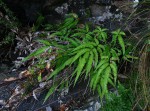Pteris cretica L.
Synonyms |
Pteris nervosa Thunb. |
|---|---|
Common name |
Avery fern |
Description |
Rhizome shortly creeping or ascending, up to 1 cm in diameter, or forming a compact woody stock and with many fibrous roots; rhizome scales lanceolate in outline, apex tapering to a point, entire, dark brown, up to 3 mm long. Fronds tufted, up to 1.2 m long, erect to arching, firmly herbaceous to coriaceous, dimorphous with the fertile fronds taller and with narrower pinnae than the sterile fronds. Stipe up to 60 cm in sterile fronds and up to 90 cm in fertile fronds, strawcoloured to brown and scaly at the base, glabrous. Sterile lamina 13-55 × 13-38 cm, ovate to triangular in outline, pinnate in the upper part, the lower part basiscopically developed, terminal pinnae larger or as long as the longest lateral pinnae; pinnae linear-lanceolate, 3-23 x 1.5-2.7 cm, apex tapering to a point, base cuneate, margins toothed, glabrous on both surfaces, veins free. Fertile lamina up to twice as large as the sterile lamina, pinnate with basal pinnae basiscopically developed; pinnae narrowly linear to narrowly lanceolate in outline, 7-20 x 0.4-1.3 cm, apex tapering to a point, base tapering, margin entire, glabrous on both surfaces. Sori linear, marginal, continuous, extending almost up to the apex; indusium membranous, entire. |
Notes | Can only be confused with Lindsaea ensifolia which has a widely creeping, slender rhizome, anastomosing veins and pinnae with entire margins. |
Derivation | cretica: from Crete; misleading as the species does not naturally occur on Crete. |
Habitat | In shade in forest undergrowth, streambanks, shaded ravines, roadside embankments, drier area on limestone outcrops. |
Distribution worldwide | Africa, Ascension I., Madagascar, Réunion and in Asia to Japan, and in southern Europe. |
Distribution in Africa |
Algeria, Angola, Burundi, Dem. Republic of Congo, Kenya, Lesotho, Malawi, Mozambique, Rwanda, South Africa, Swaziland, Tanzania , Uganda, Zambia, Zimbabwe. |
Growth form |
Terrestrial. |
Literature |
|
